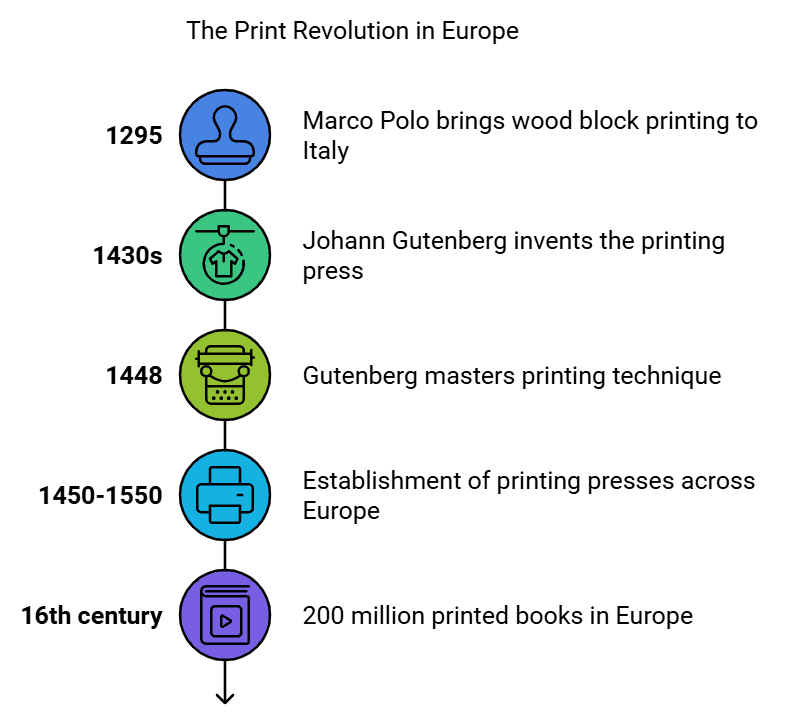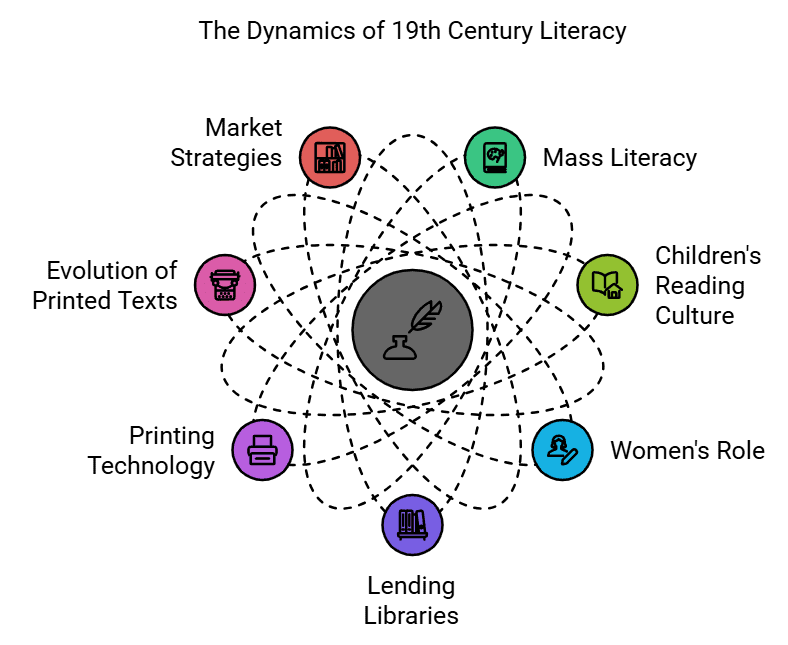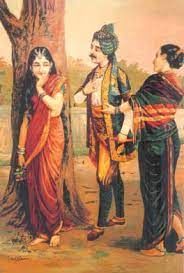Class 10 Exam > Class 10 Notes > Social Studies (SST) Class 10 > Key Concepts: Print Culture & The Modern World
Key Concepts: Print Culture & The Modern World | Social Studies (SST) Class 10 PDF Download
The First Printed Books
- Print technology was developed in China, Japan and Korea first.
- It was a system of handprinting. From AD 594, books were printed by rubbing paper against the inked surface of wood blocks. Chinese books were folded and stitched at the sides.
- Skilled craftsmen duplicated, with remarkable accuracy, the beautiful calligraphy.
- China was a major producer of printed material for a long time.

- 17th century: Print diversified. Merchants used print in their everyday life. Reading became a popular leisure activity. Rich women, wives of scholar-officials, published their plays and poetry.
- By the 19th century: Western powers started exporting new technology to China. Shift from handprinting to mechanical printing. The oldest printed book known is a Japanese Buddhist book, the Diamond Sutra printed in AD 868.
- Buddhist missionaries from China introduced handprinting technology in Japan around 768-770 AD.
In the 18th century: Edo (Tokyo) published illustrated collection of paintings, showing urban culture; hundreds of books published on cooking, famous places, women, musical instruments, tea ceremony. etc. From Japan, this art travelled to Europe and the USA.
Question for Key Concepts: Print Culture & The Modern WorldTry yourself: In which century did print technology diversify and become a popular leisure activity in China?View Solution
Print Comes To Europe

- In 1295, Marco Polo, a great Italian explorer, brought the art of wood block printing from China to Italy. From Italy it spread to other European countries.
- So far handwritten, expensive books were written on vellum, a parchment made from the skin of animals, for the rich only.
- Popularity of books led to book fairs in all parts of Europe but handwritten books were expensive, time-consuming, fragile and awkward to carry.
- First Printing Press– invented by Johann Gutenberg of Germany in the 1430s.
- Gutenberg, son of a merchant, mastered printing technique by 1448. First book he printed was the Bible. It took him 3 years to print 180 copies.
- From 1450-1550 printing presses were set up in most countries of Europe. The second half of the 15th century saw 20 million printed books in Europe, by the 16th century the number was 200 million copies.
- William Caxton set up the first printing press in England.
- The shift from handprinting to mechanical printing led to the Print Revolution.
 William Caxton
William Caxton
Question for Key Concepts: Print Culture & The Modern WorldTry yourself: Who brought the art of wood block printing from China to Italy?View Solution
The Print Revolution and Its Impact
- Print Revolution:
Transformation in producing books, influencing lives and relationships with information.
Extended beyond development, altering perceptions and introducing new ways of looking at things. - New Reading Public:
Printing press reduced book costs, making them accessible to a growing readership.
Created a culture of reading among common people, transitioning from an oral to a reading culture. - Transition Challenges:
Limited literacy rates posed a challenge in reaching the masses.
Publishers bridged the gap by publishing illustrated popular ballads and folk tales, merging oral and print cultures. 
- Religious Debates and Fear of Print:
Print allowed wide circulation of ideas, sparking debates and discussions.
Authorities, including religious figures, expressed fears about the uncontrolled spread of rebellious and irreligious thoughts. - Impact on Religion:
Martin Luther's Ninety-Five Theses, printed and widely circulated, led to the Protestant Reformation.
Print played a crucial role in spreading new ideas and fostering an intellectual atmosphere. - Print and Dissent:
Popular religious literature led to diverse interpretations of faith, even among the less educated.
Instances like Menocchio in Italy, who faced execution for challenging established religious views, highlighted the impact of print. - Control Measures:
Responding to dissent, the Roman Catholic Church imposed controls on publishers and booksellers.
Maintained an Index of Prohibited Books from 1558 to regulate the spread of 'heretical' ideas.
The Reading Mania
- Literacy Growth in Europe:
Seventeenth and eighteenth centuries witnessed increased literacy rates.
Churches established schools, reaching peasants and artisans, resulting in literacy rates of 60-80% in some European regions by the late eighteenth century. - Reading Mania and Popular Literature:
Print led to a virtual reading mania with a demand for books.
New forms of popular literature emerged, including almanacs, ballads, folktales, and affordable chapbooks, reaching ordinary readers. - Periodical Press and Access to Knowledge:
Periodical press developed in the early eighteenth century, combining current affairs with entertainment.
Scientists' and philosophers' ideas became accessible to the common people through published texts, maps, and diagrams.

- Role of Books in Enlightenment:
Common belief in the mid-eighteenth century that books were agents of progress and enlightenment.
Many believed books could liberate society from despotism, heralding an era of reason and intellect. - Print Culture and French Revolution:
Print culture contributed to the conditions for the French Revolution.
Arguments: popularization of Enlightenment ideas, creation of a culture of dialogue and debate, literature criticizing royalty, and questioning the existing social order. - Impact of Enlightenment Thinkers:
Enlightenment thinkers like Voltaire and Rousseau widely read, challenging tradition, superstition, and despotism.
Their writings influenced readers to view the world critically and rationally. - Literature Mocking Royalty:
Outpouring of literature in the 1780s mocked royalty, questioning their morality and social order.
Cartoons and caricatures circulated underground, fostering hostile sentiments against the monarchy. - Print's Influence on Public Opinion:
Print opened up the possibility of thinking differently.
People exposed to diverse literature interpreted and accepted/rejected ideas in their own way.
Print did not directly shape minds but facilitated varied perspectives.
The Nineteenth Century
- Mass Literacy in the 19th Century:
Significant increase in mass literacy in 19th-century Europe.
New readers emerged, including children, women, and workers. - Children's Reading Culture:
Compulsory primary education in the late 19th century led to children becoming important readers.
Establishment of a children's press in France in 1857, focusing on literature for children.
Grimm Brothers in Germany compiled traditional folk tales, edited for publication, changing rural folk tales.

- Role of Women in Reading and Writing:
Women became crucial readers and writers in the 19th century.
Penny magazines and manuals on behavior and housekeeping targeted women.
Renowned female novelists such as Jane Austen, Bronte sisters, and George Eliot contributed to defining a new type of woman. - Lending Libraries and Working Class Education:
Lending libraries in 19th-century England served as educational tools for white-collar workers, artisans, and the lower-middle class.
Self-educated working-class individuals wrote political tracts and autobiographies. - Printing Technology Innovations:
Press evolved from metal to power-driven cylindrical press by Richard M. Hoe in the mid-19th century.
Late 19th-century saw the development of the offset press capable of printing multiple colors simultaneously.
Electrically operated presses from the early 20th century accelerated printing operations. - Evolution of Printed Texts:
Continuous mechanical improvements transformed the appearance of printed texts.
Printers and publishers adopted new strategies, such as serializing important novels in 19th-century periodicals. - Market Strategies and Publishing Innovations:
1920s in England witnessed the sale of popular works in cheap series like the Shilling Series.
20th-century innovation: introduction of the dust cover or book jacket.
During the Great Depression in the 1930s, publishers released cheap paperback editions to sustain book purchases.
India and the World of Print
- India has a very old and rich tradition of handwritten manuscripts– in Sanskrit, Arabic,Persian as well as vernacular languages.
- Problems of Handwritten books:
(i) very expensive
(ii) very fragile
(iii) had to be handled carefully and
(iv) script written in different styles– could not be read easily - Print comes to India in the mid-16th century to Goa, brought by the Portuguese.
- In 1579, Catholics print first Tamil book at Cochin. In 1773, the first Malayalam book was printed by them. Dutch Protestant missionaries print 32 Tamil texts.

- First regular periodical in India, Hickey’s Bengal Gazette, in English in the late 17th century.
- First Indian Newspaper to appear, the weekly, Bengal Gazette by Raja Rammohun Roy’s associate Gangadhar Bhattacharya.
- Early 19th century, age of reforms, intense debates around religious issues.
- Traditional practices criticised, new ideas emerged.
- Hindu Orthodoxy debated widow remarriage, sati,monotheism,idolatry and Brahmanical priesthood.
- Rammohun Roy published Sambad Kaunudi from 1821. Hindu Orthodoxy published Samachar Chandrika to oppose his ideas.
- Two Persian newspapers published – Jam-i-Jahan Nama and Shamsul Akhbar.
- Gujarati newspaper Bombay Samachar was published from 1822.
- The Ulema, afraid of the English changing the Muslim Personal Laws, printed newspapers in Urdu and Persian.
- Deoband Seminary, founded in 1867, published fatwas telling Muslims how to behave.
- Ramcharitmanas by Tulsidas was first printed from Calcutta in 1810.
- The Naval Kishore Press of Lucknow, known as the most prestigious publishing house in this period, made great contribution to Urdu publication.
- Shri Venkateshwar Press of Bombay, another famous firm, published literature in vernacular languages.
- Thus, print connected various people, communities, sects in different parts of the country.
- It contributed to the growth of pan-Indian identities.
Question for Key Concepts: Print Culture & The Modern WorldTry yourself:Which was the first Indian newspaper to appear?
View Solution
Religious Reform and Public Debates
- Religious Debates in the 19th Century:
Intense debates on religious issues during the early 19th century in colonial society.
Different groups offered varied interpretations and responses to the changes, leading to clashes of opinions. - Role of Print in Religious Debates:
Printed tracts and newspapers played a crucial role in spreading and shaping new ideas.
Enabled a wider public to participate in public discussions and express their views. - Controversies in Bengal:
Debates in Bengal included widow immolation, monotheism, Brahmanical priesthood, and idolatry.
Rammohan Roy's Sambad Kaumudi (1821) and the Hindu orthodoxy's Samachar Chandrika were among the publications shaping the discourse.

- Print in Different Languages:
To reach a wider audience, ideas were printed in the everyday language of ordinary people.
Persian newspapers (Jam-i-Jahan Nama, Shamsul Akhbar), Gujarati newspaper (Bombay Samachar), and publications in Urdu played significant roles. - Muslim Responses:
Muslim responses involved the use of cheap lithographic presses to counter the anxieties about the collapse of Muslim dynasties.
Deoband Seminary (1867) published fatwas, explaining Islamic doctrines and guiding everyday conduct. - Diversity of Muslim Sects:
Throughout the 19th century, various Muslim sects and seminaries emerged with different interpretations of faith.
Urdu print facilitated their public battles and debates. - Encouragement of Reading Religious Texts:
Print encouraged the reading of religious texts among Hindus, especially in vernacular languages.
Calcutta saw the first printed edition of the Ramcharitmanas in 1810, followed by cheap lithographic editions in north Indian markets. - Widespread Accessibility:
Printed and portable religious texts reached a broad audience, easily read by the faithful anywhere.
Facilitated group readings for illiterate individuals. - Connectivity through Print:
Print not only stimulated conflicting opinions but also connected communities across different parts of India.
Newspapers conveyed news, fostering pan-Indian identities.
New Forms of Publication
- Print and the Novel in India:
Printing created a demand for new forms of writing.
The novel, originating in Europe, adapted to Indian forms and styles, reflecting diverse human experiences. - Diversity in Literary Forms:
Besides novels, other literary forms like lyrics, short stories, and essays on social and political matters gained popularity.
Emphasis on human lives, emotions, and political and social rules. - Visual Culture and Print:
By the late 19th century, visual culture emerged with the setup of more printing presses.
Painters like Raja Ravi Varma produced images for mass circulation.
Cheap prints and calendars decorated homes, shaping ideas about modernity, tradition, religion, politics, society, and culture.

- Emergence of Caricatures and Cartoons:
Caricatures and cartoons in the 1870s commented on social and political issues.
Addressed issues like Western influence, fear of social change, and imperial rule. - Women and Print Culture:
Women's lives and emotions written vividly; women's reading increased.
Liberal families educated women at home and in schools; some rebel women defied conservative prohibitions.
Women authors in Bengal, Maharashtra, and elsewhere wrote about women's experiences, education, widowhood, and societal issues. - Development of Hindi Printing:
Hindi printing gained significance from the 1870s, focusing on women's education.
Women-authored and -edited journals became popular in the early 20th century, addressing women's issues and providing household lessons. - Folk Literature and Women's Education:
In Punjab, folk literature taught women to be obedient wives.
Cheap booklets disseminated messages about qualities of a good woman. - Battala in Calcutta:
The Battala area in central Calcutta became a hub for printing popular books.
Cheap editions, including religious tracts and scandalous literature, were widely available with illustrations. - Print and the Poor:
Very cheap small books sold in Madras towns at crossroads; public libraries set up from the early 20th century.
Issues of caste discrimination discussed in printed tracts.
Leaders like Jyotiba Phule, B.R. Ambedkar, and Periyar wrote powerfully on caste. - Worker's Voices in Print:
- Factory workers, initially overworked and lacking education, later expressed their experiences in print.
- Kashibaba and Sudarshan Chakra wrote about caste and class exploitation.
- Bangalore cotton millworkers set up libraries in the 1930s to educate themselves, inspired by Bombay workers, with support from social reformers.
Print and Censorship
- Pre-1798: Limited Censorship:
East India Company showed little concern for censorship.
Early measures targeted critical Englishmen in India fearing trade monopoly challenges. - 1820s: Press Regulations:
Calcutta Supreme Court initiated regulations controlling press freedom.
Company encouraged newspapers supporting British rule.
Governor-General Bentinck revised press laws in 1835, restoring earlier freedoms. - Post-1857: Changing Attitudes:
After 1857 revolt, English demand for press clampdown increased.
Vernacular newspapers turned nationalist, triggering colonial government debates on stringent control. - 1878: Vernacular Press Act:
Modeled on Irish Press Laws, granted extensive government rights to censor vernacular press reports.
Government monitored vernacular newspapers across provinces.
Warning issued for seditious content; non-compliance led to press seizure and machinery confiscation. - Nationalist Newspapers' Growth:
Despite repression, nationalist newspapers expanded.
Reported on colonial misrule, fostering nationalist activities.
Suppression attempts provoked militant protests, creating a cycle of persecution and protests. - 1907: Punjab Revolutionaries' Deportation:
Deportation of Punjab revolutionaries in 1907 led to sympathetic coverage in Kesari by Balgangadhar Tilak.
Tilak's imprisonment in 1908 sparked widespread protests throughout India.
The document Key Concepts: Print Culture & The Modern World | Social Studies (SST) Class 10 is a part of the Class 10 Course Social Studies (SST) Class 10.
All you need of Class 10 at this link: Class 10
|
94 videos|630 docs|79 tests
|
FAQs on Key Concepts: Print Culture & The Modern World - Social Studies (SST) Class 10
| 1. What were the first printed books and why were they significant? |  |
Ans.The first printed books, known as incunabula, were produced in Europe in the 15th century after the invention of the printing press by Johannes Gutenberg. The most famous of these is the Gutenberg Bible. These books were significant because they made literature and knowledge more accessible to the general public, leading to increased literacy rates and the spread of ideas during the Renaissance.
| 2. How did the print revolution impact society in Europe? |  |
Ans.The print revolution drastically transformed society in Europe by facilitating the spread of information and ideas. It contributed to the rise of a literate middle class, enabled the Reformation by allowing religious texts to be disseminated widely, and fostered public debates on various social and political issues. The availability of printed materials also encouraged individual interpretation of texts, particularly religious ones.
| 3. What was the role of print in the Nineteenth Century? |  |
Ans.In the Nineteenth Century, print played a crucial role in shaping public opinion and promoting social change. The rise of newspapers, magazines, and books allowed for diverse voices and perspectives to emerge. This period also saw the growth of print culture in the form of novels, which became popular among the masses, contributing to the development of national identities and movements for social reform.
| 4. How did print influence religious reform and public debates? |  |
Ans.Print had a profound influence on religious reform and public debates by providing a platform for the dissemination of new ideas and critiques of established doctrines. Figures like Martin Luther used printed pamphlets to challenge the Catholic Church, leading to the Protestant Reformation. The widespread availability of printed materials fostered public discourse on various issues, including politics, education, and social justice.
| 5. What challenges did print face in terms of censorship? |  |
Ans.Print faced significant challenges in terms of censorship, as governments and religious authorities sought to control the dissemination of information that could undermine their power. Censorship laws were enacted to restrict the publication of certain materials, and printers often faced persecution for producing controversial works. Despite these obstacles, the demand for printed materials often led to resistance against censorship, highlighting the struggle for freedom of expression.
Related Searches






















